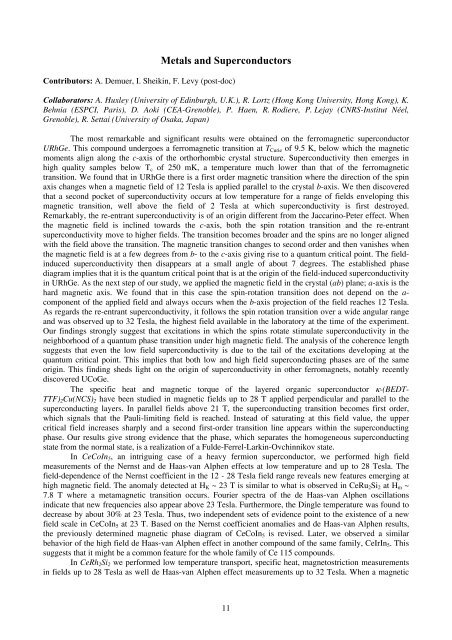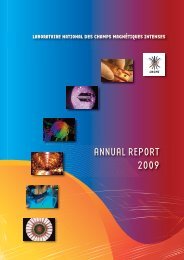Laboratoire National des Champs Magnétiques Pulsés CNRS – INSA
Laboratoire National des Champs Magnétiques Pulsés CNRS – INSA
Laboratoire National des Champs Magnétiques Pulsés CNRS – INSA
Create successful ePaper yourself
Turn your PDF publications into a flip-book with our unique Google optimized e-Paper software.
Metals and Superconductors<br />
Contributors: A. Demuer, I. Sheikin, F. Levy (post-doc)<br />
Collaborators: A. Huxley (University of Edinburgh, U.K.), R. Lortz (Hong Kong University, Hong Kong), K.<br />
Behnia (ESPCI, Paris), D. Aoki (CEA-Grenoble), P. Haen, R. Rodiere, P. Lejay (<strong>CNRS</strong>-Institut Néel,<br />
Grenoble), R. Settai (University of Osaka, Japan)<br />
The most remarkable and significant results were obtained on the ferromagnetic superconductor<br />
URhGe. This compound undergoes a ferromagnetic transition at TCurie of 9.5 K, below which the magnetic<br />
moments align along the c-axis of the orthorhombic crystal structure. Superconductivity then emerges in<br />
high quality samples below Tc of 250 mK, a temperature much lower than that of the ferromagnetic<br />
transition. We found that in URhGe there is a first order magnetic transition where the direction of the spin<br />
axis changes when a magnetic field of 12 Tesla is applied parallel to the crystal b-axis. We then discovered<br />
that a second pocket of superconductivity occurs at low temperature for a range of fields enveloping this<br />
magnetic transition, well above the field of 2 Tesla at which superconductivity is first <strong>des</strong>troyed.<br />
Remarkably, the re-entrant superconductivity is of an origin different from the Jaccarino-Peter effect. When<br />
the magnetic field is inclined towards the c-axis, both the spin rotation transition and the re-entrant<br />
superconductivity move to higher fields. The transition becomes broader and the spins are no longer aligned<br />
with the field above the transition. The magnetic transition changes to second order and then vanishes when<br />
the magnetic field is at a few degrees from b- to the c-axis giving rise to a quantum critical point. The fieldinduced<br />
superconductivity then disappears at a small angle of about 7 degrees. The established phase<br />
diagram implies that it is the quantum critical point that is at the origin of the field-induced superconductivity<br />
in URhGe. As the next step of our study, we applied the magnetic field in the crystal (ab) plane; a-axis is the<br />
hard magnetic axis. We found that in this case the spin-rotation transition does not depend on the acomponent<br />
of the applied field and always occurs when the b-axis projection of the field reaches 12 Tesla.<br />
As regards the re-entrant superconductivity, it follows the spin rotation transition over a wide angular range<br />
and was observed up to 32 Tesla, the highest field available in the laboratory at the time of the experiment.<br />
Our findings strongly suggest that excitations in which the spins rotate stimulate superconductivity in the<br />
neighborhood of a quantum phase transition under high magnetic field. The analysis of the coherence length<br />
suggests that even the low field superconductivity is due to the tail of the excitations developing at the<br />
quantum critical point. This implies that both low and high field superconducting phases are of the same<br />
origin. This finding sheds light on the origin of superconductivity in other ferromagnets, notably recently<br />
discovered UCoGe.<br />
The specific heat and magnetic torque of the layered organic superconductor κ-(BEDT-<br />
TTF)2Cu(NCS)2 have been studied in magnetic fields up to 28 T applied perpendicular and parallel to the<br />
superconducting layers. In parallel fields above 21 T, the superconducting transition becomes first order,<br />
which signals that the Pauli-limiting field is reached. Instead of saturating at this field value, the upper<br />
critical field increases sharply and a second first-order transition line appears within the superconducting<br />
phase. Our results give strong evidence that the phase, which separates the homogeneous superconducting<br />
state from the normal state, is a realization of a Fulde-Ferrel-Larkin-Ovchinnikov state.<br />
In CeCoIn5, an intriguing case of a heavy fermion superconductor, we performed high field<br />
measurements of the Nernst and de Haas-van Alphen effects at low temperature and up to 28 Tesla. The<br />
field-dependence of the Nernst coefficient in the 12 - 28 Tesla field range reveals new features emerging at<br />
high magnetic field. The anomaly detected at HK ~ 23 T is similar to what is observed in CeRu2Si2 at Hm ~<br />
7.8 T where a metamagnetic transition occurs. Fourier spectra of the de Haas-van Alphen oscillations<br />
indicate that new frequencies also appear above 23 Tesla. Furthermore, the Dingle temperature was found to<br />
decrease by about 30% at 23 Tesla. Thus, two independent sets of evidence point to the existence of a new<br />
field scale in CeCoIn5 at 23 T. Based on the Nernst coefficient anomalies and de Haas-van Alphen results,<br />
the previously determined magnetic phase diagram of CeCoIn5 is revised. Later, we observed a similar<br />
behavior of the high field de Haas-van Alphen effect in another compound of the same family, CeIrIn5. This<br />
suggests that it might be a common feature for the whole family of Ce 115 compounds.<br />
In CeRh2Si2 we performed low temperature transport, specific heat, magnetostriction measurements<br />
in fields up to 28 Tesla as well de Haas-van Alphen effect measurements up to 32 Tesla. When a magnetic<br />
11







